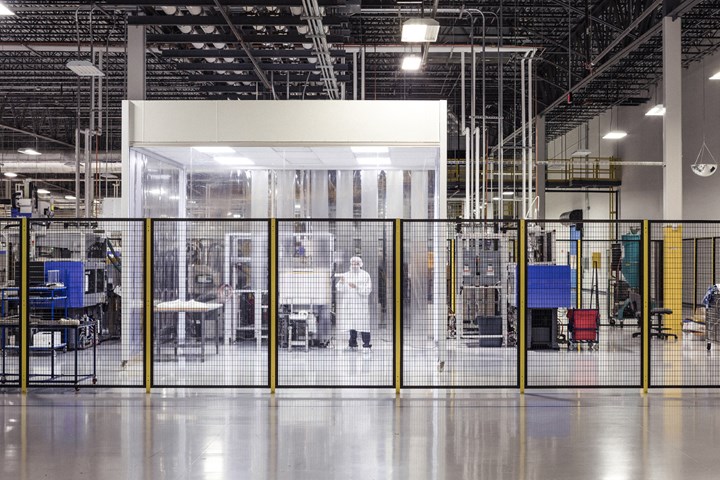
Cleanrooms help eliminate potential manufacturing conditions that could damage microfluidic parts during the molding process. Photo Credit: Canon Virginia Inc.
Fast diagnostic results, small fluid samples and convenient testing—all of these factors make microfluidics an appealing and timely option for industries that require rapid diagnostic testing. In the healthcare industry, particularly, the COVID-19 pandemic has heightened the need for small devices that can quickly deliver test results. At the point of care, microfluidic devices can help enable early detection, slow the spread of disease and ultimately save lives with early treatment.
What Is Microfluidics?
Microfluidics is a technology that handles controlled amounts of fluid within dimensions of tens to hundreds of micrometers. These devices can move fluid through micro-sized channels to create controlled chemical reactions—sometimes the size of a smartphone.
Featured Content
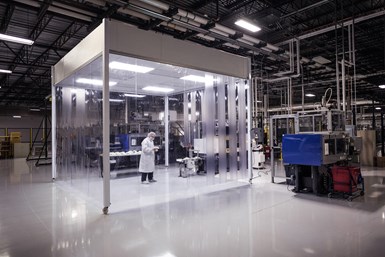
Moldmaking for microfluidics requires highly controlled environments for more precision and control.
With these devices, medical professionals can deliver affordable diagnostic testing quickly—for example, point-of-care applications in the medical industry. However, medical applications are not the only place for microfluidics. Any industry using a liquid or gas in a chemical reaction could use microfluidic devices for rapid, convenient testing applications.
Potential industry applications include food safety for farmworkers to test bacteria levels of produce at the site; commercial aircraft for flight crews to quickly and accurately monitor cabin air quality; and indoor air quality for HVAC technicians to detect airborne pathogens quickly.
Despite the compelling advantages of microfluidics, industries have yet to widely commercialize this technology because manufacturing microfluidic devices have typically required expensive materials and labor-intensive processes.
Traditional methods for manufacturing microfluidic parts involve machining materials like glass, silicon and metal. While these materials and methods work well, they are labor-intensive and expensive, making it difficult for manufacturers to justify the cost of mass production.
The key reason precision moldmaking can enable commercialization is that low-cost, high-volume production is achievable with injection molding of microfluidic parts from high-precision molds.
Precision Moldmaking Helps Create Plastic Microfluidic Parts
Due to the nano-sized channels, surface roughness and detection mechanisms required, microfluidic parts demand the highest precision in manufacturing. Despite these constraints, recent advances in precision moldmaking technology can provide the accuracy necessary to produce repeatable microfluidic tools. Meeting these challenging requirements means the micro-precision injection-molded thermoplastics of today can produce a repeatable form factor that delivers the nano-thicknesses required of the microfluidic devices of tomorrow.
Plastic injection molds require equipment capable of machining at an extremely high degree of precision. During production, the mold builder must machine these molds in a controlled atmosphere, keeping to incredibly sensitive temperature and humidity specifications. In one example, the temperature around a machine is kept within ±0.05oC, which is difficult to do. The humidity control is kept at 45%, ±15% in that same room. Some molds for microfluidic parts are so sensitive to oxidation that even breathing on them can compromise their integrity.
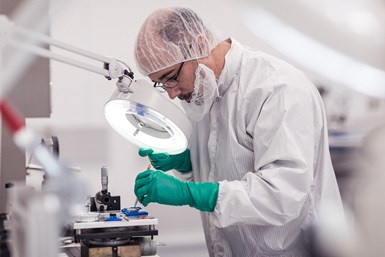
Manufacturing microfluidics depends on high precision at the micro-scale, due to the nano-sized channels and detection mechanisms of the devices.
High-precision mold builders should also engineer ways to control vibration, as this can disrupt the surface finish of microfluidic parts. It is important to understand why this level of precision is necessary. First, if the surface roughness is too great, it can inhibit the resolution of certain microfluidic properties, depending on the application. Second, microfluidic parts need to be bonded to a surface substrate to work correctly. Often, if the requirement for surface roughness cannot be reached, the part may fail. A third reason is that many parts rely on transparency to properly function. If the surface roughness is not precise enough, it may make the part less transparent, hurting its functionality.
Microfluidic devices may require channels and corners less than a thousandth of an inch thick to operate properly. Given the size of the channels, machine tools capable of machining microfluidic parts must be able to machine walls that are often less than 0.1 millimeter thick. This type of high-precision mold machining can produce mirror-like surface finishes with no burr; further polishing by hand is not needed. In fact, unlike traditional moldmaking, high-precision machining can polish surfaces to such a high level that any further work done by hand would mar the surface.
These particularly tight tolerances protect the integrity of the delicate microfluidic parts they will produce. With such a high-quality form factor, mold builders can help injection molders to establish a repeatable, dependable process to create reliable, inexpensive microfluidic parts.
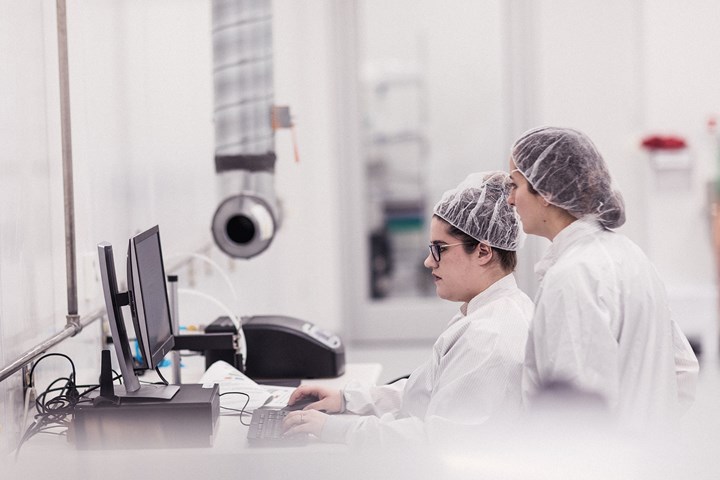
With microfluidic devices, medical device manufacturers can enable fast, low-cost diagnostic testing at scale.
Injection Molding Delivers Microfluidic Parts
With the help of a high-precision mold builder, injection molders can use thermoplastics to develop parts that previously could only be made with more expensive material. However, plastic injection molding brings new challenges to microfluidic part production.
The reality that variations in plastic material can affect the shrinkage and final part dimensions is a serious concern. Injection molders must accommodate for this and adapt to changes in the plastic material. This is, of course, true of all plastic parts, but the tolerances in microfluidic parts are so small that thermoplastics were not previously seen as a viable production material. However, with extremely precise molds and processes, the tight tolerances that microfluidic parts require are now possible.
The need for faster diagnoses, more access to point-of-care testing and improved, cost-efficient manufacturing capabilities are driving industries toward mass production of microfluidics. Thankfully for manufacturers, injection molding could offer an affordable path to production. By manufacturing high-precision molds and using them to fabricate microfluidic devices, manufacturers can industrialize their production, generating high volumes at a low cost.
The key reason precision moldmaking can enable commercialization is that low-cost, high-volume production is achievable with injection molding of microfluidic parts from high-precision molds. For example, at a machine shop rate of $75 to $100 per hour, the cost per part can go through the roof when machining microfluidic parts from traditional methods and materials. But by leveraging plastic injection molding instead of silicon or glass, manufacturers can quickly realize the return on their investment.
When considering the material requirements and processes for creating these microfluidic parts, precision must stay top of mind.
Moldmaker Advancement Helps Overcome Microfluidic Challenges
Canon Virginia Inc. (Newport News, Virginia) developed its technology capable of machining surface finishes with single-digit nanometer tolerances. When checking for tolerances between peaks and valleys on a machined part’s surface, Canon’s proprietary machining can achieve tolerances within 30 nanometers.
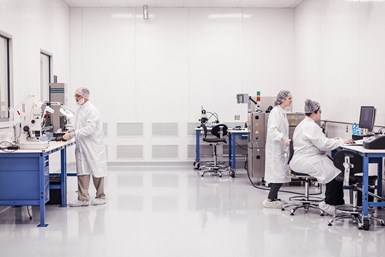
Due to the nano-sized channels, surface roughness and detection mechanisms required, microfluidic parts demand the highest precision in manufacturing.
Manufacturing parts at a microscopic level requires specialized equipment, instruments and expertise—all of which can be expensive barriers to adoption. Having the right partnerships enables manufacturers to create tooling for precision microfluidic parts and reduce costs, scale their production and ensure device functionality.
Even with Canon’s proprietary precision moldmaking, successfully manufacturing microfluidic devices for any industry is not easy. Fluids behave differently at the micro-scale, so engineers need a strong understanding of physics, materials science and engineering to build an effective microfluidic device. When considering the material requirements and processes for creating these microfluidic parts, precision must stay top of mind.
The path to producing microfluidic devices is challenging, but the possibilities that plastic injection molding and ultra-precise tooling provide can pave a cost-effective way forward.
RELATED CONTENT
-
Baffle Blades in Plastic Injection Molds
Turbulent-flow plastic baffles eliminate blow-by, significantly improving cooling and cycle times.
-
Detecting Water Flow Restrictions
A look at how taking the time and data to analyze a mold problem will help you repair it right—and permanently—the first time.
-
It Starts With the Part: A Plastic Part Checklist Ensures Good Mold Design
All successful mold build projects start with examining the part to be molded to ensure it is moldable and will meet the customers' production objectives.













